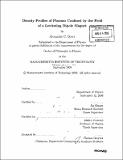| dc.contributor.advisor | Jay Kesner and Miklos Porkolab. | en_US |
| dc.contributor.author | Boxer, Alexander C | en_US |
| dc.contributor.other | Massachusetts Institute of Technology. Dept. of Physics. | en_US |
| dc.date.accessioned | 2010-03-25T15:13:12Z | |
| dc.date.available | 2010-03-25T15:13:12Z | |
| dc.date.copyright | 2008 | en_US |
| dc.date.issued | 2009 | en_US |
| dc.identifier.uri | http://hdl.handle.net/1721.1/53195 | |
| dc.description | Thesis (Ph. D.)--Massachusetts Institute of Technology, Dept. of Physics, February 2009. | en_US |
| dc.description | "September 2008." Cataloged from PDF version of thesis. | en_US |
| dc.description | Includes bibliographical references (p. 211-218). | en_US |
| dc.description.abstract | A 4-channel microwave interferometer (center frequency: 60 GHz) has been constructed to measure the density profiles of plasmas confined within the Levitated Dipole Experiment (LDX). LDX is the first and only experiment built to study plasmas confined by the field of a levitating, dipole magnet in a geometry that exploits plasma compressibility to achieve stability. Theoretical predictions--based partly on observations of planetary magnetospheres-suggest that dipole-confined plasmas will be driven by fluctuations into pressure and density profiles that are "stationary" to MHD interchange modes. The stationary pressure profile is characterized by an equal amount of entropy per flux-tube while the stationary density profile is characterized by an equal number of particles per flux-tube. These predictions are of interest to nuclear fusion research since they imply that the pressure and density profiles of dipole-confined plasmas can be simultaneously peaked and stable. Measurements with the interferometer show that the total density of LDX plasmas is strongly affected by the following parameters: levitated vs. mechanical support of the central dipole coil; input ECRH frequency and power; background pressure of neutral particles; plasma species. The gradients of the density profiles are, however, largely independent of the experimental conditions and approximate the value predicted for the stationary profile. Non-linear analyses suggest that dipole-confined plasmas are maintained in their stationary pressure and density profiles by a process of self-organized convection. We present measurements indicating that this self-organization process is observed in LDX. | en_US |
| dc.description.statementofresponsibility | by Alexander C. Boxer. | en_US |
| dc.format.extent | 218 p. | en_US |
| dc.language.iso | eng | en_US |
| dc.publisher | Massachusetts Institute of Technology | en_US |
| dc.rights | M.I.T. theses are protected by
copyright. They may be viewed from this source for any purpose, but
reproduction or distribution in any format is prohibited without written
permission. See provided URL for inquiries about permission. | en_US |
| dc.rights.uri | http://dspace.mit.edu/handle/1721.1/7582 | en_US |
| dc.subject | Physics. | en_US |
| dc.title | Density profiles of plasmas confined by the field of a Levitating Dipole Magnet | en_US |
| dc.type | Thesis | en_US |
| dc.description.degree | Ph.D. | en_US |
| dc.contributor.department | Massachusetts Institute of Technology. Department of Physics | |
| dc.identifier.oclc | 526629803 | en_US |
